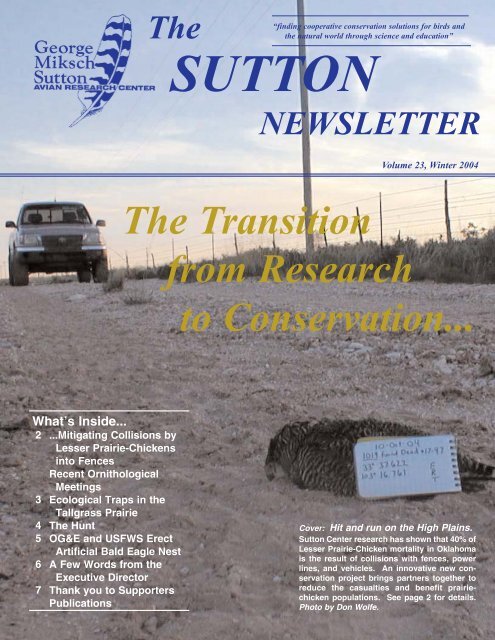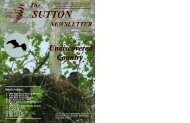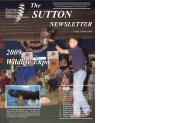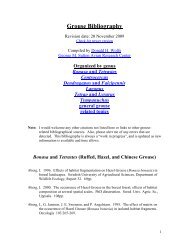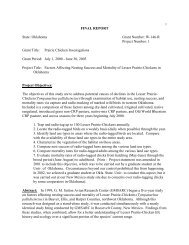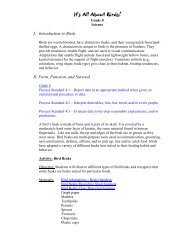Download now - George Miksch Sutton Avian Research Center
Download now - George Miksch Sutton Avian Research Center
Download now - George Miksch Sutton Avian Research Center
You also want an ePaper? Increase the reach of your titles
YUMPU automatically turns print PDFs into web optimized ePapers that Google loves.
TheSUTTON“finding cooperative conservation solutions for birds andthe natural world through science and education”NEWSLETTERVolume 23, Winter 2004The Transitionfrom <strong>Research</strong>to Conservation...What’s Inside...234567...Mitigating Collisions byLesser Prairie-Chickensinto FencesRecent OrnithologicalMeetingsEcological Traps in theTallgrass PrairieThe HuntOG&E and USFWS ErectArtificial Bald Eagle NestA Few Words from theExecutive DirectorThank you to SupportersPublicationsCover: Hit and run on the High Plains.<strong>Sutton</strong> <strong>Center</strong> research has shown that 40% ofLesser Prairie-Chicken mortality in Oklahomais the result of collisions with fences, powerlines, and vehicles. An innovative new conservationproject brings partners together toreduce the casualties and benefit prairiechickenpopulations. See page 2 for details.Photo by Don Wolfe.
Ecological Traps in Tallgrass Prairie: Effects ofManagement on Bird Nest Successby Eyal ShochatWhen the cues upon which animals select their habitats actually resultin choosing areas where reproductive output is decreased, a habitatbecomes an ecological trap. This phenomenon is especially common inhuman-managed ecosystems. The tallgrass prairie of Oklahoma has beenmanaged for many decades with prescribed fires and livestock grazing.The regrowth of lush vegetation following spring fires attracts into thefields many arthropods and, consequently, their predators—the breedingbirds. However, the change in vegetation structure following fires alsofacilitates nest predator movement through the tallgrass. How do thesechanges affect breeding bird habitat selection and nest predation?We addressed this question by monitoring nearly 2600 nests of 26 birdspecies in tallgrass prairie plots during five breeding seasons(1992–1996). These included undisturbed, grazed only, and burned and grazed plots (18 plots of 40 acres each). In the last threeyears we also recorded arthropod and predator (reptiles, birds and mammals) abundance in these plots. For each nest we recordedwhether it succeeded or failed, and in the latter case, the reason for failure.The best way to assess breeding habitat preference is to compare bird densities between habitats as the overall bird densitykeeps increasing during spring. In low densities, birds should enter their primary (preferred) habitat only. In high densities theywill start using other habitats in the landscape, but their densities in the primary habitat will always exceed their densities in lesspreferred habitats. We found that on average, each spring, breedingbirds first enter burned and grazed plots, followed by grazed onlyplots. Undisturbed plots were the last to be entered. This pattern concurredwith arthropod abundance, which was the highest in burned andgrazed plots and the lowest in undisturbed plots. It suggests that thecue for habitat selection is the amount of food available for nestlings.However, despite the better food conditions in disturbed plots, nestsuccess was the highest in undisturbed plots where food was less abundant,and lowest in burned and grazed plots where food was the mostabundant. We therefore examined the causes of nest failure. We foundthat 80% of all nests failed as a result of predation and that the proportionof failures resulting from predation increases from undisturbedplots to burned and grazed plots.Predator observations revealed that these differences in nest predationwere associated with predator abundance. Reptilian and avianpredators were most abundant in burned and grazed plots. Reptilesaccounted for 80% of all predators. This may explain the differences innest survival rates between ground-, shrub-, and tree-nesting species.Whereas ground- and shrub- nesting species had similar nest survivalprobabilities, nest survival was significantly higher for tree-nesters.We concluded that certain management practices in the tallgrassprairie can turn it into an ecological trap for breeding birds. Birds areattracted to burned or grazed areas by higher food abundance, but predatorabundance is also higher in these areas. The predators, mostly reptiles,have a negative effect on nest success, especially of ground-nestingspecies. Therefore, bird conservation may benefit from sustaininga relatively large proportion of unburned areas in the landscape eachspring. These unburned areas may hold smaller populations of breedingbirds than disturbed areas, but they may better support self-sustainingbird populations.The <strong>Sutton</strong> Newsletter 3
Dan ReinkingSometimes the Hunt Comes Up Emptyby Michael A. PattenScience is a human endeavor. Despite a Herculean striving toward objectivity, science is fraught unavoidably with basichuman fallibility. Failings are often slight and typically self-correcting, the latter being a key strength of the scientific process.But in the short term, at least, reporting bias can paint a distorted picture. This bias arises as a result of a profound tendencyto publish only those findings thought to be notable or important, often meaning little more than they are significant statistically.As a consequence of this tendency, numerous studies—no one really k<strong>now</strong>s exactly how many—that failed to achieve conventionalsignificance fail to see the light of day. Such studies are instead filed away by the researcher and are soon forgotten.Hence, this "file-drawer problem" (Rosenthal 1979, Csada et al. 1996, Bachau 1997, Scargle 2000) yields a skewed view of thenatural world. As an example, the <strong>Sutton</strong> <strong>Center</strong> recently conducted two analyses that could easily end up in the file drawer.The analyses concern population declines and mortality patterns of, respectively, the Greater and Lesser Prairie-Chickens,two uncommon grouse of grassland habitats. The first study concerned the relationship between grain prices and populationlevels of the Greater Prairie-Chicken. The premise was that these birds benefit from extensive planting of certain head grains,particularly milo. Price would determine how much milo was grown and thus how much was available to the birds. Yet thecorrelation between the price of milo over a 37-year period (1962–1998), corrected for inflation, and the size of the prairiechickenpopulation in those years, was not significant (r = -0.18, P > 0.20). We concluded that any relationship between grainprice and population fluctuations was nonexistent or, at least, unimportant.We later tackled the hypothesis that Lesser Prairie-Chicken mortality by way of raptors, mammals, or collisions, is relatedto moon phase. Although the moon tended to be less illuminated for mammal kills (see the adjoining figure), analyses failedto detect a significant relationship between phase and type of mortality.Perhaps data incorporating temperature and cloud cover would yield a significanttrend, but as it stands we cannot conclude that the proportion of themoon that is illuminated is related to prairie-chicken mortality.Literature CitedBachau V (1997) Is there a ‘‘file drawer problem'' in biological research? Oikos79:407–409.Csada RD,James PC, Espie RHM (1996) The "file-drawer problem" of non-significantresults: Does it apply to biological research? Oikos 76:591–593.Rosenthal R (1979) The "file drawer problem" and tolerance of null results. Psych.Bull. 86:638–641.Scargle JD (2000) Publication bias: The "file-drawer" problem in scientific inference.J. Sci. Explor. 14:91–106.Ornithological Meetings (Continued from page 2)Mist netting LeConte’s Sparrowsat the Tallgrass Prairie Preserve.wildlife and landscapes of Iceland. <strong>George</strong> <strong>Miksch</strong> <strong>Sutton</strong> spent the summer of 1958 in Iceland,and published the book Iceland Summer in 1961. Dan revisited many of the places <strong>Sutton</strong> wroteabout, and photographed many of the species <strong>Sutton</strong> drew and painted in his book.The OOS was founded in 1950 to encourage the study and conservation of birds inOklahoma. For more information about the OOS, visit www.okbirds.org.Inland Bird Banding AssociationThe Inland Bird Banding Association (IBBA) held its annual meeting in early November, atthe <strong>Sutton</strong> <strong>Center</strong>, where our recent renovations made hosting a scientific paper session for ameeting like this much more practical. On Friday evening, <strong>Sutton</strong> <strong>Center</strong> Executive DirectorSteve Sherrod presented an overview of the history and projects of the <strong>Sutton</strong> <strong>Center</strong>. AssistantDirector Alan Jenkins then gave a program on regulations, techniques, and practical considerationsfor trapping roadside raptors. A Saturday morning bird banding workshop at the TallgrassPrairie Preserve was held to demonstrate techniques for mist netting and banding grassland birds, including the elusive Le Conte'sSparrow and Sedge Wren, both of which were successfully captured and banded.Saturday afternoon was spent at the <strong>Sutton</strong> <strong>Center</strong>, where presentations of a variety of scientific studies using bird banding tomonitor bird populations were given. Following an evening banquet at the meeting hotel, <strong>Sutton</strong> <strong>Center</strong> biologist Don Wolfe presenteda program on our nearly 10 years of research studying prairie-chickens using radio telemetry.The IBBA was organized in 1922, and its membership engages in the study of birds and their conservation. For more informationabout the IBBA, visit www.aves.net/inlandbba/.4 The <strong>Sutton</strong> Newsletter
OG&E and USFWS Erect anArtificial Bald Eagle Nesttext and photos by M. Alan JenkinsIn 1995 the Payne County Audubon Society noticed a new Bald Eagle nestbeing built at Sooner Lake, located midway between Stillwater and Ponca Cityon U.S. Highway 177. This lake is used as a cooling pond for the Sooner PowerPlant run by Oklahoma Gas and Electric Company (OG&E). The nest can beseen from Oklahoma Highway 15 by traveling 1¼ miles east of Highway 177.There is a turnout there on the south side of Highway 15 where you can park andlook to the south and see the large nest in the remains of a dead cottonwood tree.In the 11 nesting seasons since 1996, these eagles have produced youngevery year, generating a total of 17 young. This is a mean reproductive rate of1.9 young/year compared with the mean of 1.6 young/year for all of Oklahoma'snesting Bald Eagles. It is thought that if a pair of eagles can fledge about 1young each year, that rate of reproduction, after mortalities, is enough to replacethe pair and result in a stable breeding population over an extended period oftime. As you can tell, this pair is doing more than its share to make sureOklahoma's nesting eagle population exceeds its replacement level and keepsincreasing.One problem: the nest is built in a dead tree in standing water, and this typeof nest will eventually fall. This particular nest territory does not have any othersuitable nesting trees in the vicinity to hold a nest after the current one is gone.One solution: build a new nest structure. The <strong>Sutton</strong> <strong>Center</strong> knew of successfulefforts by conservationists in Arizona to build artificial nest structures forBald Eagles in areas where there were no suitable trees. Their plans were published,so we decided to approach OG&E to see if they would be willing to constructand erect a new eagle nest platform. Steve Sherrod, Don Wolfe, and I metwith OG&E environmental management personnel, including David Braneckyand Erv Warren, along with Kevin Stubbs and Stephanie Harmon of the U.S.Fish & Wildlife Service and Russ Horton of the Oklahoma Department ofWildlife Conservation. OG&E called the meeting to explore the ways theycould improve the wildlife habitat on the Sooner Lake Plant site. Discussioncentered on improving Sooner Lake habitats for Greater Prairie-Chickens,Interior Least Terns (an endangered species), and Bald Eagles (a threatenedspecies). The <strong>Sutton</strong> <strong>Center</strong>, OG&E, and the government agencies decided toerect an artificial Bald Eagle nest platform near the present nest to be used (weall hoped) after the currently used tree fell into the water. Also, owing to thepublic nature of the lake, an opportunity to do some science and conservationeducation with signage near the highway existed. The Fish & Wildlife Servicewould pay most of the costs, OG&E would pay for the remainder and providemanpower, engineering, and construct the platform tower.After a meeting to discuss and finalize the engineering plans, a steel columnwith anchored guy wires would be put near the nest. It was constructed with aninverted pyramid cup on top that would hold nesting material. On November 3(and therefore before the nesting season) OG&E used a crane to place the artificialnest in the water. Although this placement made the job more difficult, itwas decided that a nest surrounded by water would be safer than one placed onthe nearby shore. We will keep you posted on this nest, or you could even visitand see it yourself; just confine your activities to the roadside and use binocularsor a scope.The <strong>Sutton</strong> Newsletter 5
A Few Words from the Executive Director...SHERROD, STEVE FrenchClub; Hi-Y Club; NHS; LORE AdManager; Soph., Jr. & Sr.Assem.; Senior Class Treas."Once a Wolverine, Always a Wolverine!" were the final e-mailed wordsfrom Lawton High School teacher, Karen Beavers, following my three presentationsat my high school alma mater during mid-November 2004. It did notseem like nearly 40 years since, on game days only, I had trod on the tilewolverine in the intersection of Lawton High's hallways. I was proud of havinga wolverine for the mascot, as I liked predators anyway, but especiallythose with serious pluck. I remembered that mascot when I saw the yellow v-ed backstripe of my first wild wolverine, many years later, loping along as<strong>now</strong>-covered slope in Canada; we were flying low in a small chopper at 60below zero just before hitting a complete whiteout, but that's another story.My presentations had been initiated when Sid Hudson, Vice-Chancellor,Oklahoma State Regents for Higher Education, gave me a call earlier in theyear about the Garfield Lectures Program. Sid and colleagues were hoping toexpand the educational opportunities afforded to students at Lawton High bybringing in alumni in various career positions, and he asked if I would be willingto talk to the kids regarding what others at the <strong>Sutton</strong> <strong>Avian</strong> <strong>Research</strong><strong>Center</strong> and I did as professionals involved with wildlife conservation. So, I puttogether a PowerPoint summary that included my days at Lawton High, undergradcollege days at OU, MS and PhD work at Brigham Young and Cornell,and <strong>Sutton</strong> <strong>Center</strong> employment including travel at various locals throughoutthe world.I suspected high schoolers would be a difficult age, simply uninterested inthe importance of environmental work, much less how birds were related. Wouldthese kids be able to relate to a bald-headed, wrinkled old man who once had aBeatle's haircut (see inset)? As the kids entered the class, I felt my suspicionswere confirmed. Nearly all of them were doing the "gangsta walk", draggingtheir feet with characteristic posture, and with an ambiance that, to me, suggestedbeing unreceptive toward learning.I was somewhat surprised at the dead silence and lack of sleepy eyes duringeach talk. Obviously the teachers had the classes well under control. When I finishedmy 40-minute presentations, the questions started slowly, but then poured forth coveringeverything from environmental subjects to completely unrelated bird questions. As the bell rang, aguy I had pegged for a real "gangsta" stopped long enough to say, "Man, you did a great job!" Another student, with Germanaccent and whose military family was associated with Ft. Sill, stayed along with others almost until the next bell excitedly chattingabout my talk and majoring in college biology. I guess Dr. Phil was right suggesting one should not assume "eye rolling"teenagers had tuned you out completely.By e-mail, Karen Beavers, mentioned above, related several students' comments following my presentations. One suggestedshe was glad an LHS graduate would return to share "real world" experiences. My emphasis on birds as worldwide samplersof both soil and air actually impressed the kids who voiced surprise that birds could impact science so significantly. Ofcourse students enjoyed the unique "gory" bird stories I had told, as well as hunting falcon episodes from around the world.The teachers stressed the importance of bringing presentations to the high school level where students are making careerand life choices, and where exposure to math and science as well as to other subjects offer a seed, some of which will sproutfor the future. I made a specific effort to show students why so many subjects, while seemingly unrelated to their present lives,will ultimately be essential in most future jobs.The statewide <strong>Sutton</strong> <strong>Center</strong> educational, live bird show, under development <strong>now</strong>, will be offered to Oklahoma secondaryschools starting fall 2005. It will relate Math and Science and various other subjects to the future of life on earth. These studentsare part of Earth's future, and we hope you will help the <strong>Sutton</strong> <strong>Avian</strong> <strong>Research</strong> <strong>Center</strong> by supporting our important effortsto present a new, exciting, environmental educational program throughout the state. Stay tuned for future news of this greatopportunity for Oklahoma students.6 The <strong>Sutton</strong> NewsletterSteve Sherrod, Executive Director
Thank You to These Loyal <strong>Sutton</strong> Supporters!January 1, 2004 through November 30, 2004Up to $99Stephanie Adair, Marilyn Baumann, Susan Billingsley, Walter & Betty Bohn, Richard Boone, Martin, Jean & Sarah Brown, William & Evelyn Browning,Kylia Bussey, Marion & Anita Cabler, Rosi & Bill Caswell, Kenneth Clucas, Clint Cox, Jacqueline Crowden, Mark Dreiling, Roz Elder, James & BettyEnderson, Bob Faber, Sherry Francis, Robert & Nell Freeman, Walter & Corinne Gerard, Larry Gilliam, Beverly Gooch, Good Earth Garden Club, GrandLake Audubon Society, May Greene, Donald & Katherine Hanson, Michael Heidebrecht, J.E. Henkle, Nina & Jim Hogue, Kenneth & Karen Hollinga,Margery Hughes, Steven & Julia Jech, Richard Kane, Fred Kirk, B. Lishman, Sally Lunn, Donna Marshall, Deborah Maxwell, Doris Mayfield, MichaelMcBride, Franklin & Virginia McCamey, Scott McConnell, Joseph & Nancy McDonald, Ann McMahon, Duane & Patricia <strong>Miksch</strong>, Marie Mildren, Debbie& Charles Moncooyea, David & Jennith Moncrief, Samuel & Helen Moore, Patty Moser, Bambi Murphey, Sheryl Myerley, Greg & Brenda Olds, AnnaParviainen, Jennifer Philp, Rob Rainey & Family, Suzanne Reeble, Jean Reehling, Lisa Rietfors & Family, Donald & Nancy Roberts, Linda E. Robinson,Terry Ryan, Joan Scheulen, Gary Schnell, Debbie Scott, Virgil & Connie Shaw, Kathryn Shinn, Gary Siftar, Donna Sisk, Brad Smith, Charlotte Smith, Trudy& Cliff Sousa, Kenneth & Ann Spence, Renee Steen, Carolyn Stewart-Earley, Andrew & Kathy Stirling, Janet Thomas, Rhoda Transue, Dennis Waggoner,Robert Wahlgren, C. S. Washburn, Roberta Webb, Paul & June Webster, Robert & Adriene Weis, Tom & Carol Wesson, Steven & Karen Smith Woods.$100 to $499Ben & Pat Abney, Gary Adams, Earl Bachenberg, Ann Bartlett, Jeff & Sheryl Bashaw, Richard Blevins, Bruce & Nancy Bolzle, Jerry & Marilou Bork, BPFoundation, Jo & Emily Brandt, Mike & Revae Brewer, Harry & Wanna Brookby, Dick & Leslie Bushaw, David & Pam Cameron, Jack Cartland, MikeCase, Ann Chilton Bartlett, William & Melba Cooledge, Patricia Daniel, Tony Davis, Eric Davis, David Delahay, Sandra Dickey, Buddy & Teresa Edwards,Danny Edwards, Terry & Michael Fenner, Steve Ganzkow, Bill Grant, Kelly Grant, Maureen Gribben, Ginger & Anne Griffin, Tim Grogan, <strong>George</strong> & SuzyHarris, Anthony & Dayna Hayes, Rudy & Deb Herrmann, Kim Holland, Jeffrey Holmes, William Hunter, Mary Ann Iverson, <strong>George</strong> & Martha Kamp,Gary & Sheila Kilpatrick, Dobie & Sandra Langenkamp, Donald & Susan Lauffer, Ed Leinbach, Joe & Yolanda Lennart, May Lewis, C. & Mary AnneLewis, Jean Little, John & Xandra Manley, Wade & Joel McWilliams, Vesna Mihailovic, Richard Mildren, Chalise Miner, Melissa Minshall, Joseph & DonaMorris, S.M. Murray, Allen & Holly Oliphant, Jim & Patti Orbison, Elizabeth Overlees, Jerry & Joan Parkhurst, JoAnn Payne, Betty & Jack Perryman,Donne Pitman, Stuart & Linda Price, Robert Price, Andrew Pringos, James Rainey, Edward & Evelyn Reed, Jack & Sondra Reeder, Rebecca Renfro, RyanRice, Lisa Riggs, Phil & Gayle Ann Roberts, Ken & Julie Smith, James Sneed, Alice Stacey, Kathryn Taylor, Harley Thomas, Michael & Susan Turpen,Suzanne & Stephen Tuttle, Brian & Pamela Ufen, Frank & Stephanie Walthall, Sharon Weaver, Albert Whitehead.$500 to $999Stephen Adams, <strong>George</strong> & Melissa Bashaw, Virginia Cohlmia, RebeccaDixon, Stephen & Ruthie Duenner, Harcourt Publishers, Lee & JanetHolcombe, H. Tom Sears, Steve & Linda Sherrod, The Nature Conservancy,Fred & Randi Wightman, Keith Wright.$1,000 to $4,999American Bank & Trust, An anonymous donation, Michael & Debbie Baab,Don Eller, Carol & Joe McGraw, Charles & Jessie Price, David Riggs, AnneShalaby, U.S. Fish and Wildlife Service, Robert & Tracy Young.$5,000 to $9,999Kenneth S. Adams Foundation, John & Donnie Brock Foundation.$10,000 to $24,999AEP/Public Service Company, H. A. and Mary K. Chapman CharitableTrust, The Helmerich Foundation, The Oxley Foundation, Riggs, Abney,Neal, Turpen, Orbison & Lewis, Tulsa World/World Publishing.$25,000 or moreConocoPhillips, F & M Bank and Trust Company, Founders and Associates,Inc., New Mexico Game and Fish Department.Memorial FundsIn memory of Jess Sherrod: Ya Ya Friends. In memory of Marge Cartland: JackCartland. In memory of Jesse Maaski: Beverly Gooch. In memory of JohnWayne Ward, M.D.: An anonymous donation. In honor of Bonnie Gall: GoodEarth Garden Club. In honor of Steve and Vicki Adams: Maureen Gribben.2004 PublicationsGarrett KL, Molina KC, Patten MA (2004) History of ornithological exploration of the Salton Sea. Studies in <strong>Avian</strong> Biology 27:18–23.Patten MA (2004) Correlates of species richness of North American bat families. Journal of Biogeography 31:975–985.Patten MA, Erickson RA, Unitt P (2004) Population changes and biogeographic affinities of the birds of the Salton Sink, California/BajaCalifornia. Studies in <strong>Avian</strong> Biology 27:24–32.Patten MA, McCaskie G (2004) Patterns and processes of the occurrence of pelagic and subtropical waterbirds at the Salton Sea. Studiesin <strong>Avian</strong> Biology 27:33–41.Patten MA, Rotenberry JT, Zuk M (2004) Habitat selection, acoustic adaptation, and the evolution of reproductive isolation. Evolution58:2144–2155.Patten MA, Smith-Patten BD (2004) Linking the Salton Sea with its past: The history and avifauna of Lake Cahuilla. Studies in <strong>Avian</strong>Biology 27:12–17.Reinking DL, ed. (2004) Oklahoma Breeding Bird Atlas. University of Oklahoma Press, Norman. 532 pp.Sapir N, Abramsky Z, Shochat E, Izhaki I. (2004) Scale-dependent habitat selection in migratory frugivorous passerines.Naturwissenschaften, 91:544–547.Shochat E (2004) Credit or debit? Resource input changes population dynamics of city-slicker birds. Oikos 106: 622–626.Shochat E, Lerman SB, Katti M, Lewis DB (2004) Linking optimal foraging behavior to bird community structure in an urban-desertlandscape: Field experiments with artificial food plots. American Naturalist 164:232–243.Shochat E, Stefanov W, Whitehouse MEA, Faeth SH (2004) Urbanization and spider diversity: influences of human modification ofhabitat structure and productivity. Ecological Applications 14:268–280.Shochat E, Tsurim I (2004) Winter bird communities in the northern Negev: species dispersal patterns, habitat use and implications for habitatconservation. Biodiversity and Conservation 13:1571–1590.The <strong>Sutton</strong> Newsletter 7
G. M. <strong>Sutton</strong> <strong>Avian</strong> <strong>Research</strong> <strong>Center</strong>P.O. Box 2007Bartlesville, OK 74005(918) 336-7778(918) 336-BIRDe-mail: GMSARC@aol.comweb site: www.suttoncenter.orgNon-Profit OrganizationU.S. Postage PaidBartlesville, OK 74003Permit #13A 501(c)3, non-profit, constituent organization of theUniversity of Oklahoma's College of Arts and Sciences and theOklahoma Biological SurveyBOARD OF DIRECTORSM. David Riggs, Chairman Tuss G. EricksonH. Tom Sears, Treasurer Warren D. HardenStephen S. AdamsM. Lee HolcombeEllen G. AdelsonCarol A. McGrawSteve C. AlterJerry P. ParkhurstBarbara L. BatesHarold C. PricePaul B. Bell Jr., Ph.D.Gary D. Schnell, Ph.D.John A. BrockSteve K. Sherrod, Ph.D.Sam P. DanielCaryn C. Vaughn, Ph.D.Rebecca L. DixonSenator Penny B.WilliamsCHAIRMAN’S ADVISORY COUNCILJoseph H. Williams, Chairman John S. ShackfordWilma P. MankillerRichard J. SherryVesna Mihailovic, M.D. Jack D. Tyler, Ph.D.Gary L. NealClayton M. White, Ph.D.SUTTON CENTER STAFFSteve K. Sherrod, Ph.D. Executive DirectorM. Alan Jenkins Assistant DirectorMichael A. Patten, Ph.D. Director of <strong>Research</strong>Dan L. ReinkingBiologistDon H. WolfeBiologistEyal Shochat, Ph.D.Post Doctoral <strong>Research</strong>erKaren A. KilbourneAdministrative AssistantSteven B. BelangerGrounds & Animal CareGenny AkinsFumiko SakodaRay ThompsonDouglas TozerPalani WhitingAmy WilliamsBonnie GallSuzy HarrisSally JenkinsNavigo.comPatricia VelteSEASONAL STAFFPrairie-Chicken StudyPrairie-Chicken StudyPrairie-Chicken StudyWinter Bird AtlasPrairie-Chicken StudyPrairie-Chicken StudyVOLUNTEERSData EntryData EntryVariousWeb Site HostingWeb Site Assistance


